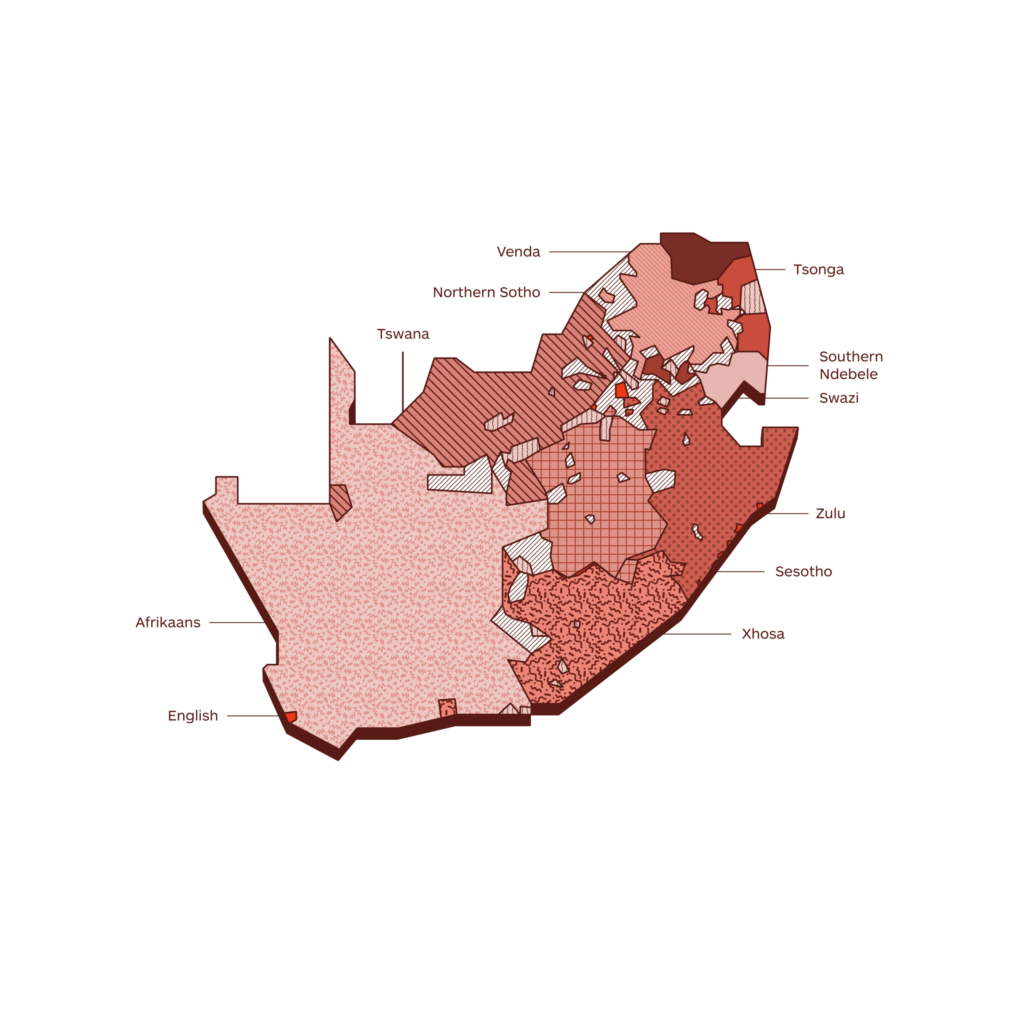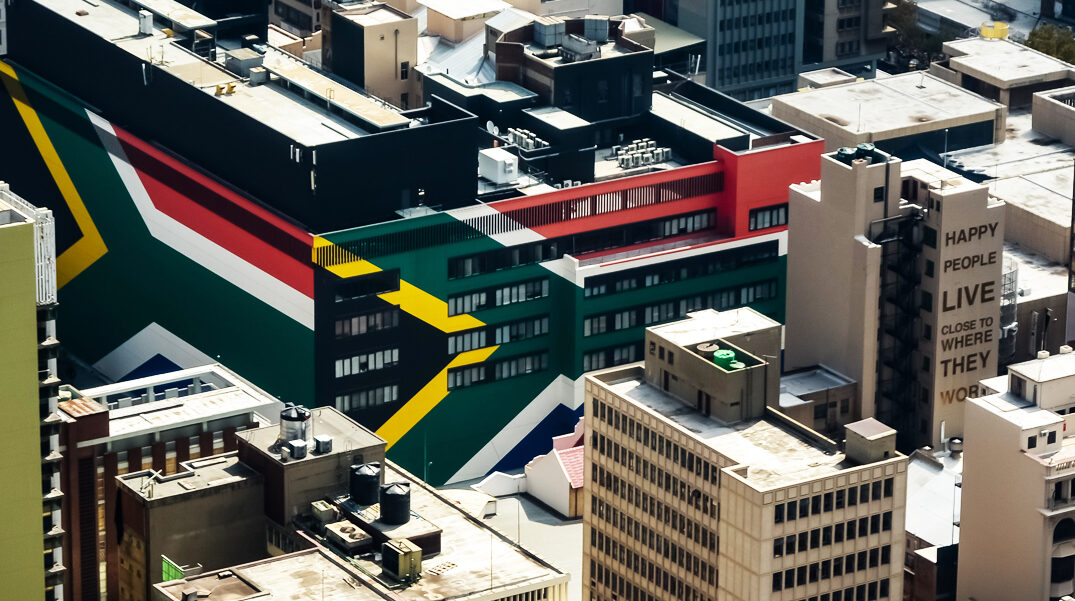Africa
To which language should you translate to localize in South Africa?
What we know from our community
“Molo, Dumela, Avuxeni, Aa/Ndaa. That is how you greet in few languages out of the eleven official
languages in South Africa spoken in nine provinces. What is interesting is that from some of the
greetings you can determine whether a person is greeting one person or, two or more people. In some
you can also determine the gender of the person who is greeting.The accents and tradition differ depending on where the speakers reside. You will find that most of the
vernacular languages speaking people in rural areas they have deep accent and are more into tradition
than those who stay in different parts of the country. Also most of them understand their mother
tongue only, while those in other parts of the country are bilingual or know more languages.“
LANGUAGE INSIGHT
Official language
Zulu (22.7%; 14.34 mln), Xhosa (16.0%; 10.11 mln), Afrikaans (13.5%; 8.53 mln), English (9.6%; 6.06 mln), Sepedi (9.1%; 5.75 mln), Tswana (8.0%; 5.05), Sesotho (7.6%; 4.80 mln), Tsonga (4.5%; 2.84 mln), Swazi (2.5%; 1.58 mln), Venda (2.4%; 1.51 mln), Ndebele (2.1%; 1.32 mln)
Actual languages
Zulu (22.7%; 14.34 mln), Xhosa (16.0%; 10.11 mln), Afrikaans (13.5%; 8.53 mln), English (9.6%; 6.06 mln), Sepedi (9.1%; 5.75 mln), Tswana (8.0%; 5.05), Sesotho (7.6%; 4.80 mln), Tsonga (4.5%; 2.84 mln), Swazi (2.5%; 1.58 mln), Venda (2.4%; 1.51 mln), Ndebele (2.1%; 1.32 mln), other (2.0%; 1.26 mln)
What the top 150 best localized websites in the world do in South Africa
(Top 150 websites listed in the Global by Design ranking – published annually by Byte Level Research, this report provides a list of globally localized websites, showcasing best practices and emerging trends in their globalization)
- 113/150 localize by translating into English
- 2/150 localize by translating into English and Afrikaans
- 2/150 localize by translating into English, Afrikaans and Zulu
- 2/150 localize by translating into English, Afrikaans, Zulu, Southern Ndebele, isiXhosa, Sesotho, Tswana and Swazi Language
- 1/150 localizes by translating into English, Afrikaans, Zulu, Southern Ndebele, isiXhosa, Sesotho and South African Sign Language
- 1/150 localizes by translating into English, French and Simplified Chinese
- 1/150 localizes by translating into English, French, Italian, Spanish, German and Simplified Chinese
- 1/150 localizes by translating into English, French and Portuguese
- 1/150 localizes by translating into English, French, Portuguese, Italian, Spanish, German, Simplified Chinese and Korean
- 1/150 localizes by translating into English, French, Portuguese, Italian, Spanish, German, Simplified Chinese, Traditional Chinese, Japanese, Thai, Ukrainian, Russian, Turkish, Romanian, Polish, Hungarian and Bahasa Indonesia
-
3M
-
ABB
-
Accenture
-
Adidas
-
Adobe
-
Airbnb
-
Aldi
-
Amazon
-
American Airlines
-
American Express
-
Apple
-
Audi
-
Autodesk
-
Avis
-
Bayer
-
BMW
-
Booking.com
-
Bosch
-
British Airways
-
Bumble
-
Burberry
-
BYD
-
Canon
-
Capgemini
-
Cartier
-
Caterpillar
-
Chevrolet
-
Cisco Systems
-
Citibank
-
Coca-Cola
-
Costco
-
Dell
-
Deloitte
-
Delta
-
DHL
-
Disney+
-
Dyson
-
eBay
-
Eli Lilly
-
Emirates
-
Ernst & Young
-
Facebook
-
FedEx
-
Ford
-
Four Seasons
-
Fujifilm
-
GE
-
Gillette
-
GoDaddy
-
Google
-
Gucci
-
Haier
-
Heineken
-
Hermès
-
Hertz
-
Hilton
-
Hisense
-
Hitachi
-
Honda
-
Hotels.com
-
HP
-
HP Enterprise
-
HSBC
-
Huawei
-
Hyatt
-
Hyundai
-
IBM
-
IKEA
-
Intel
-
InterContinental Hotels
-
J&J
-
Jack Daniel's
-
Jehovah’s Witnesses
-
John Deere
-
Kellogg's
-
Kia
-
KPMG
-
L'Oréal
-
Land Rover
-
LEGO
-
Lenovo
-
Lexus
-
LG
-
Louis Vuitton
-
Lululemon
-
LUSH
-
Marriott
-
MasterCard
-
McDonald's
-
Mercedes-Benz
-
Merck
-
Microsoft
-
Mitsubishi Electric
-
Nestlé
-
Netflix
-
Nike
-
Nikon
-
Nintendo
-
Nio
-
Nissan
-
NIVEA
-
Oracle
-
Pampers
-
Panasonic
-
PayPal
-
Pepsi
-
Pfizer
-
Philips
-
Pitney Bowes
-
Porsche
-
Procter & Gamble
-
PWC
-
Revolut
-
Rolex
-
Royal Caribbean
-
Salesforce
-
Samsung
-
Sanofi
-
SAP
-
Sephora
-
Shopify
-
Siemens
-
Sony
-
Spotify
-
Starbucks
-
Steelcase
-
Stripe
-
Subaru
-
Tesla
-
The Church of Jesus Christ of Latter-day Saints
-
Tiffany
-
Tinder
-
Toshiba
-
Toyota
-
TripAdvisor
-
Uber
-
United Airlines
-
UPS
-
Visa
-
Volkswagen
-
Volvo Cars
-
Vrbo
-
Walmart
-
Western Union
-
Wikipedia
-
Wise
-
WordPress
-
Workday
-
Xerox
-
Xiaomi (Mi)
-
Zara
-
Zoom
If you need others information, below you can find a selection of economic/social/cultural data
Overview
Language
Official language
Zulu (22.7%), Xhosa (16.0%), Afrikaans (13.5%), English (9.6%), Sepedi (9.1%), Tswana (8.0%), Sesotho (7.6%), Tsonga (4.5%), Swazi (2.5%), Venda (2.4%), Ndebele (2.1%).
T-index 0.44%
T-Index ranks countries according to their potential for online sales.
English
High proficiency (EF) – 11 of 111 countries/regions in the world- 1/24 position in Africa.
Demography
Capitals: Cape Town, Pretoria, Bloemfontein
Currency: South African Rand
Population: 63.212 mln
Population density: 51/km2
Economy
GDP: 377.8 billion USD (2023)
GDP per capita: 6.253,16 USD (2023)
Exports: 147 billion USD (2022)
Statistics
Unemployment rate: 27.99% (2023)
Urbanisation: 69% (2023)
Literacy: 90% (2021)
Internet users: 74.7% penetration, 45.34 million
By 2025 more than 50% of SubSaharan Africa will have a mobile connection, of which 65% will have a smartphone. This will result in more than 475 million mobile internet users; the top three markets for smartphone users are projected to be Nigeria, South Africa, and Kenya.
Conventions
Numbering system
Arabic numerals and comma as decimal separator. The comma is official. but the point is used in business
Date format: yyyy – mm – dd / dd – mm – yyyy
Time: 24h time system
Country code: 0027
Language data sources: Worldatlas/Britannica//EF/Wikipedia; Demography data sources: IMF/Worldometers; Conventions data source: Wikipedia; Economy data sources: WTO/OEC/CIA/Esomar/Datareportal; Statistics data sources: Datareportal/WorldBank/UN/UNESCO/CEIC/IMF/Culturalatlas/Commisceoglobal/Worlddata.info
Facts and data
Economy
Imports
113 billion USD (2022). Refined Petroleum ($17.1B), Cars ($4.62B), Crude Petroleum ($4.34B), Motor vehicles; parts and accessories (8701 to 8705) ($3.76B), and Broadcasting Equipment ($3.12B), importing mostly from China ($23.5B), Germany ($9.67B), India ($8.32B), United States ($6.11B), and Saudi Arabia ($4.5B).
Financial inclusion factors (over 15 years of age)
• 84.1% have an account with a financial institution
• 10% have a credit card
• 36.6% have a mobile money account
• 9.7% make online purchases
Ease of doing business
It is easy to conduct business (rated 67 out of 100). Ranked 4th out of 48 Sub-Saharan African countries. Ranked 84th out of 190 countries worldwide (2023, World Bank).
Exports
147 billion USD (2022). Gold ($22.7B), Platinum ($19.1B), Coal Briquettes ($12.7B), Cars ($6.89B), and Diamonds ($6.22B), exporting mostly to China ($23.4B), United States ($10.9B), Germany ($9.96B), India ($9.14B), and Japan ($8.85B).
In 2022, South Africa was the world’s biggest exporter of Platinum ($19.1B), Manganese Ore ($2.96B), Chromium Ore ($2.51B), Precious Metal Ore ($1.97B), and Titanium Ore ($656M).
Main local online stores
Amazon, Takealot.com and McAfee. Other top retail sites include BidorBuy, Alibaba, Apple, Pricecheck.co.za, eBay, Makro.co.za and Woolworths.
Economic freedom
‘Mostly not free’ (rated 55.3 out of 100). Ranked 18th out of 47 African countries. Ranked 111th out of 176 countries worldwide (2024, Heritage Foundation and Wall Street Journal).
Global Innovation Index
Ranked 2nd out of 28 Sub-Sahara African countries, 59th out of 132 worldwide.
The Global Innovation Index captures the innovation
ecosystem performance of 132 economies and tracks the most recent global innovation trends.
Economy data sources: WTO/OEC/CIA/Esomar/Datareportal
Service Imports (2018)
Service Exports (2018)
Source: OEC
Trade balance of goods from 2013 to 2023
Source: Statista
Historical Data Trade Imports
The following section uses historical trade data imports from partners of South Africa.
Historical Data Trade Exports
The following section uses historical trade data exports from partners of South Africa.
Source: OEC
South Africa's Most Complex Exports
The Product Complexity Index (PCI) measures the knowledge intensity of a product by considering the knowledge intensity of its exporters.
The Top Export Opportunities for South Africa by Relatedness
Relatedness measures the distance between a country's current exports and each product by showing only products that South Africa is not specialized in.
Source: OEC
South Africa's Most Specialized Products
Specialization is measured using Revealed Comparative Advantage (RCA), an index that takes the ratio between South Africa observed and expected exports in each product.
Source: OEC
Perception of products made in selected countries in 2017
Source: Statista
Which attributes do you associate with products made in South Africa?
Source: Statista
Market Growth Imports (2018)
This score represents the likelihood that the given country will start importing that product in the next few years. It forecasts the opening of a new specific market.
Market Growth Exports (2018)
This score represents the likelihood that the given country will start exporting that product in the next few years. It forecasts the opening of a new specific market.
Source: OEC
Foreign direct investment, net inflows (% of GDP)
Source: WorldBank

T-index
Reach most of the online purchasing power
T-Index ranks countries according to their potential for online sales. It estimates the market share of each country in relation to global e-commerce.
Try it nowMedia
Media language Most used language is English, followed by Afrikaans, but all the 11 official languages are represented.
Information channels
South Africa is a major media player. There is an established state-owned and private broadcasting scene, and a thriving satellite and cable TV industry. South African company MultiChoice, which operates the DStv platform, markets its pay TV services in dozens of African countries. The state broadcaster, the South African Broadcasting Corporation (SABC), runs TV and radio networks operating in multiple languages. But in recent years it has endured financial difficulties, accusations of political censorship, and a scandal surrounding a former executive. The lively press scene is dominated by a handful of major publishing groups. Reporters Without Borders says coverage of certain subjects involving the ruling ANC and government finances is off limits, or provokes a hostile reaction from the authorities. There were nearly 31 million internet users by the end of 2017 – comprising more than half of the population (InternetWorldStats). Internet use is driven by the use of mobile devices. Access is unrestricted, says Freedom House.
The press
The Star – Johannesburg-based daily, city’s oldest newspaper
The Sowetan – Johannesburg-based tabloid.
Beeld – largest Afrikaans daily
Mail & Guardian – weekly, operates Mail & Guardian online
Business Day – daily
Financial Mail – business weekly
Sunday Times/The Times – oldest Sunday newspaper; publishes subscription-only daily
News24 – online news
Television
SABC – state broadcaster, operates three national TV networks, two pay-TV channels.
e.tv – free-to-air, commercial; also operates news network eNCA
M-Net – pay-TV, pan-African audience
Radio
SABC – state broadcaster with regional and national services in multiple languages, including: English-language SAfm; music station 5 FM; Afrikaans station Radio Sonder Grense; Zulu station Ukhozi FM; Sesotho station Lesedi FM.
Channel Africa – SABC’s pan-African external radio
YFM – popular Johannesburg commercial R&B, soul and hip-hop station
702 Talk Radio – Johannesburg commercial news and talk station
News agency
African News Agency – news and content syndication service
Media data source: BBC
Internet Data
Internet users
74.7% penetration, 45.34 million
Share of web traffic by device
82.02% mobile phones, 19.95% computers (laptops and desktops), 1% tablet devices, others 0.03%
Median speed of mobile Internet connection
49.71 Mbps
Median speed of fixed Internet connection
45.62 Mbps
Mobile connection as a percentage of total population
195.4%
Percentage of mobile connections that are broadband (3G-5G)
97%
Most popular web search engines
Google (94.48%), Bing (4.77%), Yahoo! (0.28%), Petal Search (0.27%), DuckDuckGo (0.11%), other (0.08%).
Most used social media
Facebook (67.61%), Pinterest (11.43%), Instagram (9.2%), Twitter (5.71%), YouTube (3.31%), LinkedIn (1.7%), Reddit (0.72%), other (0.33%).
Internet data sources: Datareportal/Statcounter
Social statistics
Life expectancy
61 yrs (2022)
Current health expenditure
8.27% of GDP (2021)
Current education expenditure
96.7% of total expenditure in public institutions
Cultural Curiosities
Every ethnic group has its own little cultural norms, some, for example, consider it impolite to make gestures with the left hand or to receive things with one hand only. Some cultures, completely different in their customs, in Zulu, for example, it is important to announce your arrival shouting your name before even entering the house, but you must be seated by the host, whereas in the Sotho culture it is mannerly to immediately sit yourself when entering a foreign environment.
Corruption perceptions Index
South Africa scored 43 out of 100, ranked 72 out 180 countries worldwide.
CO2 emissions
6.7 metric tons per capita.
Graduates (tertiary education)
Educational attainment is still low in South Africa. In 2018, over half (59%) of 25–64 year-olds in South Africa had attained an upper secondary education as the highest level achieved, well above the G20 average of 32% and the OECD average of 38%, while 26% had not attained upper secondary education. However, attainment has been increasing, particularly since the implementation of the South African School Act in 1996 making education compulsory for children aged 7 to 15. Between 2008 and 2018, the share of young adults (25-34 year olds) without upper secondary education fell from 27% to 18%, with 77% of young adults having an upper secondary or post-secondary non-tertiary qualification in 2018. (2019)
World Happiness Index
South Africa ranked 91 out of 146 countries, with a score of 5.194.
Social statistics sources: WorldBank/UN/UNESCO/CEIC/IMF
The Data Factbook is a work in progress project. Our community is helping us to fill it up always with new and updated data. Your contribution is precious. If you want to help us, please write your advices at imminent@translated.com
Country Curiosities
South Africa’s Indigenous Khoe-San people, including the San and Khoikhoi, have roots dating back 11,000 years. Representing just 1% of the population, they speak unique non-Bantu languages with click sounds. In 2020, Khoisan members occupied land near Table Mountain, demanding tribal recognition and land rights. Despite the National Khoisan Council’s efforts, they remain unrecognized by law. Their ongoing struggle highlights South Africa’s complex journey toward Indigenous justice.
Additionally…
- South Africa is the “Rainbow Nation” with 12 official languages and a rich cultural mix.
- It’s the 7th-largest wine producer, home to Route 62, the world’s longest wine route.
- South Africa uniquely has three capitals: Pretoria, Bloemfontein, and Cape Town.
- South Africa hosted the World Cups for rugby (1995), cricket (2003), and football (2010)—the only nation besides England to host all three!
- The world’s first heart transplant was performed in Cape Town in 1967.
- Lesotho, a sovereign “Kingdom in the Sky,” lies entirely within South Africa’s borders.
- South Africa legalized same-sex marriage in 2006, leading LGBTQ+ equality efforts in Africa.
- In 1989, South Africa became the first country to voluntarily dismantle its nuclear weapons program.
- South Africa produces 70% of the world’s platinum, dominating global supply.
- Ranked 17th in the 2015 Global Gender Gap Report, it surpassed the UK (18), US (28), Canada (30), Australia (36), and France (57).
Languages research
Main languages families in South Africa

Legend
-
Afrikaans
-
English
-
Northern Sotho
-
Sesotho
-
Southern Ndebele
-
Swazi
-
Tsonga
-
Tswana
-
Venda
-
Xhosa
-
Zulu
-
Uninhabited
The geographical distribution of languages that you will find in the maps published in this section is a work in progress. Our community is helping us to fill it up with always new and updated data. Your contribution is precious. If you want to help us, please write to imminent.factbook@translated.com
Photo credit: Jacques Nel, Unsplash


